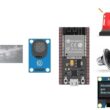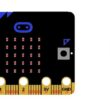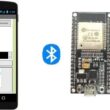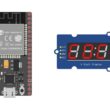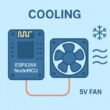Gas alarm system controlled by Arduino UNO
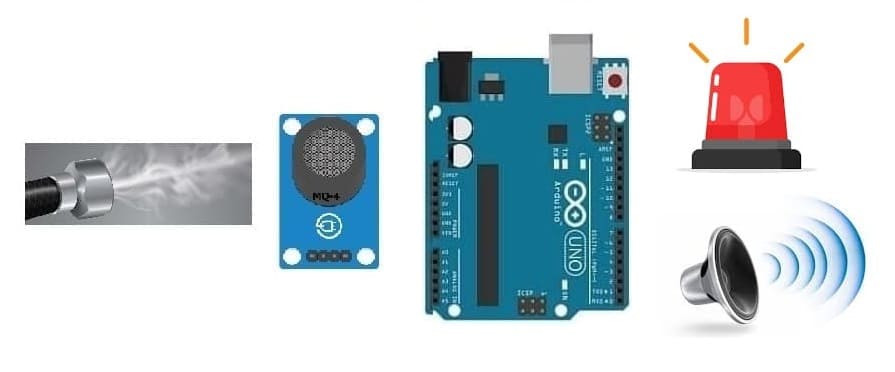
Tutorial plan
Introduction
1- How the gas alarm system works ?
2- Gas alarm system components
3- Mounting Arduino UNO board with MQ-4 sensor, LED and Buzzer
4- Program Arduino UNO board to control the system
Introduction
A gas alarm system is a safety device designed to detect the presence of potentially harmful gases in an environment, such as carbon monoxide (CO), natural gas, propane, methane, or other combustible gases. These systems are commonly used in homes, commercial buildings, industrial facilities, and other locations where gas leaks could pose a threat to health and safety.
Here's how a typical gas alarm system works:
1- Gas Sensors: Gas alarm systems contain sensors that are capable of detecting specific types of gases. These sensors continuously monitor the air for the presence of gases, and when they detect a gas at a certain concentration level, they trigger an alarm.
2- Alarm Devices: When a gas is detected, the system activates alarm devices such as sirens, strobe lights, or audible alerts to warn occupants of the building about the potential danger. These alarms are usually loud and conspicuous to ensure they can be easily heard or seen.
3- Monitoring and Notification: In some cases, gas alarm systems are connected to monitoring services that can provide remote monitoring and notifications. This allows for immediate response in case of a gas leak, even if no one is present at the location where the alarm is installed.
4- Integration with Building Systems: Advanced gas alarm systems may be integrated with other building systems, such as ventilation systems or shut-off valves for gas lines. This integration allows for automated responses to gas leaks, such as activating ventilation to remove the gas from the building or shutting off the gas supply to prevent further leaks.
5- Maintenance and Testing: Regular maintenance and testing of gas alarm systems are essential to ensure their proper functioning. This includes periodic calibration of sensors, testing of alarm devices, and replacing batteries or other components as needed.
Overall, gas alarm systems play a crucial role in preventing accidents and protecting occupants from the dangers associated with gas leaks. They provide early warning of potential hazards, allowing people to take appropriate actions to mitigate the risks and ensure their safety.
How the gas alarm system works ?
The gas alarm system based on Arduino UNO, MQ-4 sensor, LED, and Buzzer works by detecting the presence of gas in the environment and alerting the user accordingly. Here's how it works:
1- Gas Detection: The MQ-4 sensor is used to detect the presence of flammable gases such as methane, propane, butane, etc., in the air. It measures the concentration of gas molecules in the surrounding environment.
2- Arduino UNO: The Arduino UNO serves as the control unit of the system. It is programmed to read data from the MQ-4 sensor at regular intervals.
3- LED: The LED serves as a visual indicator to signal the presence of gas. When a dangerous concentration of gas is detected, the LED is illuminated to warn the user.
4- Buzzer: The buzzer is used as an audible alarm to alert the user in case of gas detection. It emits a loud and repetitive sound signal to draw the user's attention.
Here's the general workflow of the gas alarm system:
1- The Arduino UNO is connected to the MQ-4 sensor, LED, and buzzer.
2- The Arduino UNO continuously reads data from the MQ-4 sensor using analog input.
3- When the concentration of gas exceeds a predefined threshold (set according to safety requirements), the Arduino UNO activates the LED to provide a visual warning and triggers the buzzer to provide an audible alarm.
4- Once the gas concentration returns to safe levels, the alarm stops, and the LED turns off, indicating that the area is secure.
5- The system continues to monitor gas levels continuously and repeats the alarm process if a new gas leak is detected.
Gas alarm system components
Arduino UNO Board
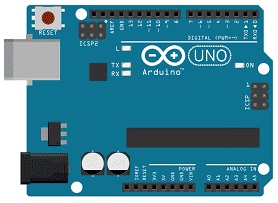
The Arduino Uno board is a microcontroller board based on the ATmega328P microcontroller. It's one of the most popular and widely used boards in the Arduino family due to its simplicity and versatility.
It is the central control unit for your project.
MQ-4 gas sensor:
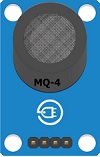
The MQ-4 gas sensor is a type of semiconductor gas sensor commonly used to detect the presence of methane (CH4) gas in the atmosphere. It belongs to a family of gas sensors known as the "MQ series," which are widely used in various applications, including industrial safety, gas leakage detection, and environmental monitoring.
LED
![]()
In an obstacle detection system, an LED (Light Emitting Diode) can be used as a visual indicator to provide feedback about the detection status. The LED can be programmed to turn on or off based on whether an obstacle is detected within a certain range.
Buzzer

The buzzer in a gas alarm system serves as an audible alert to warn occupants of a potential gas leak
Jumper Wires:

For making temporary connections and wiring between components.
Breadboard:

A breadboard is a useful tool for creating temporary electronic circuits. It allows you to connect components without soldering.
Mounting Arduino UNO board with MQ-4 sensor, LED and Buzzer
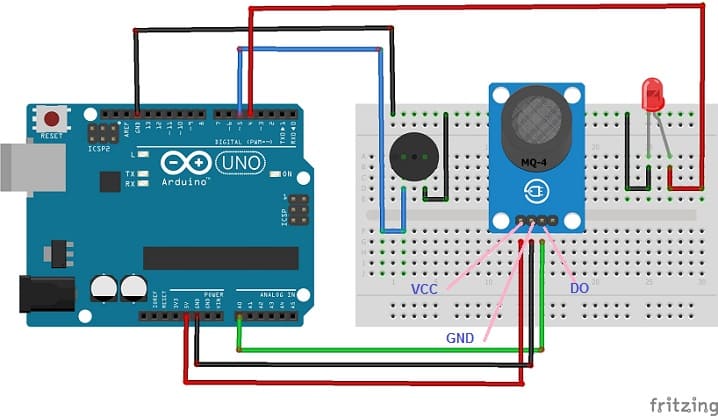
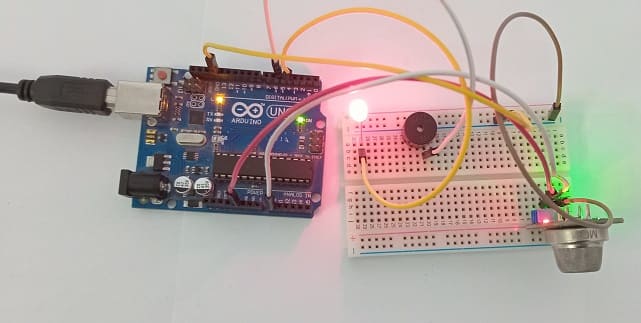
Attaching the MQ-4 sensor :
- Connect the VCC pin of the MQ-4 sensor to the 5V pin of the Arduino UNO board
- Connect the GND pin of the MQ-4 sensor to the GND pin of the Arduino UNO board
- Connect the DO pin of the MQ-4 sensor to the A0 pin of the Arduino UNO board
Attaching the buzzer :
- Connect the (+) terminal of buzzer to pin 5 of the Arduino UNO board.
- Connect the (-) terminal of buzzer to GND pin of the Arduino UNO board.
Attaching the red LED :
- Connect the negative terminal (cathode) of LED to the ground (GND) of the Arduino UNO board.
- Connect the positive terminal (cathode) of LED to pin 4 of the Arduino UNO board.
Program the Arduino UNO board to control the system
Below is an example code to program the gas alarm system based on Arduino UNO, MQ-4 sensor, LED, and Buzzer:
|
1 2 3 4 5 6 7 8 9 10 11 12 13 14 15 16 17 18 19 20 21 22 23 24 25 26 27 28 29 30 31 32 |
// Pin definitions int buzzer_pin = 5; / Digital pin for Buzzer int redled_pin = 4; // Digital pin for LED int analogPin = A0; // Analog pin for MQ-4 sensor int analogVal; //analog readings <span class="hljs-type">const</span> <span class="hljs-type">int</span> detection_threshold = <span class="hljs-number">300</span>; <span class="hljs-comment">// Detection threshold for gas</span> void setup() { <span class="hljs-comment">// Begin serial communication for debugging</span> Serial.begin(9600); <span class="hljs-comment">// Initialize pins</span> pinMode(buzzer_pin, OUTPUT); pinMode(redled_pin, OUTPUT); } void loop () { analogVal = analogRead(analogPin); // Read analog value from MQ-4 sensor Serial.print("gaz= "); Serial.print(analogVal); // Print gas value for debugging // Read the analog interface if (analogVal<=detection_threshold) // Si le capteur detecte une fuite de gaz { <span class="hljs-comment">// Turn on LED and Buzzer</span> digitalWrite(buzzer_pin, HIGH); digitalWrite(redled_pin, HIGH); } else { // Turn off LED and Buzzer digitalWrite(buzzer_pin, LOW); digitalWrite(redled_pin, LOW); } delay(100); } |
This code sets up the Arduino to read the analog data from the MQ-4 gas sensor. Depending on the value read, it activates the LED and Buzzer if the gas concentration surpasses a certain threshold. The detection_threshold can be adjusted according to specific needs.



















